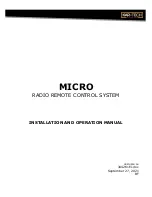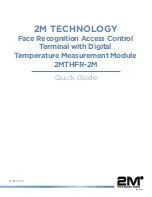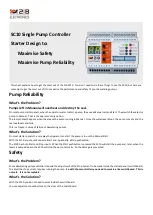
If activation state forcing is enabled (dOA
is not 0), the compressor and/or fan out-
puts can be activated when the time set in
parameters dCO and dFO expires.
Parameter H11 is used to configure the
digital input with values between -9 and
+9. Positive and negative values are used
to select the polarity assigned to the input
and:
NOTE:
the sign “-” indicates that the input is
activated when the contact is closed
The ‘+’ sign indicates that the input is
activated when the contact is open
DEVICE STAND-BY CONTROLLER
This controls the operating mode of the
device when it is on stand by according to
the following parameters:
The Stand-by controller can be digital input
or button enabled if suitably configured.
The status of the instrument when on
stand-by is determined by the value of
parameter H08. Three possible operating
modes are defined:
EXAMPLE 1: the display is off and the con-
trollers active, the instrument signals any
alarms by reactivating the display - OFF DIS-
PLAY
EXAMPLE 2: the display is off and all the
controllers, including the alarms, are also
disabled - STAND-BY
EXAMPLE 3: the display shows the “OFF”
label and all the controllers, including the
alarms, are also disabled- STAND-BY
LINK
The Link function is used to connect up to
8 instruments (1 Master device and 7 slave
devices). The distance between one device
and another must be 7 metres maximum
whereas the maximum distance between
the first and last instrument in the network
must be approximately 50m.
NOTE: the serial link between the devices is
powered.
Master
Instrument that controls the networks and
sends commands to the Slaves. The Master
is selected using parameter L00 (the value 0
defines the Master)
Slave
Instrument(s) with own controllers that also
perform(s) commands issued by the Master
(with parameters L03..L06).
Echo
This only displays the values of the instru-
ment that it is associated with (it does not
therefore have its own I/O resources but
only serves as a repeater).
NOTE: only one Echo can be connected to
anyone instrument.
Defrosting
The Link network controls defrosting. The
Master sends the defrost command which
can be performed synchronously (at the
same time) or sequentially (one defrost
after another) without affecting the normal
protections or delays for each instrument
(see parameter L03).
Other Functions
The Master can also activate the functions
associated with buttons or the Digital Input
for all the Slaves: switching lights on/off,
alarm silencing, auxiliary set point, auxiliary
relay, stand-by (on/off) and functions relat-
ed to Night & Day controller (see parame-
ter L05).
The Master can also synchronize the Slave
(or Echo device) displays with the Master
device display (see parameter L04).
NOTE: synchronized defrosting refers to
actual defrosting and not to dripping and
subsequent defrosting. The defrost LED on
the Slave units blinks when synchronized
defrosting has terminated and the Slaves
are awaiting for the thermostat control to
be enabled by the Master.
The functions are associated with the
instruments by correctly setting the para-
meters (see the parameter table for the
“Lin” label folder)
DEFROST CONTROL
The instrument can be used to select dif-
ferent types of defrosting with the para-
meter dty, defrost type.
(defrost execution mode).
The dty parameter can have these values:
0 = electrical defrosting; the compressor is
turned off.
1 = cycle reversing defrosting (hot gas);
the compressor continues operating.
2 = Free mode defrosting (compressor dis
abled).
Configuration of 3
rd
probe as 2nd evap-
orator probe
The 3
a
probe can be used to control the
defrosting of a second evaporator by con-
figuring a relay output as a 2nd evaporator
defrost relay (see par. H21…H26).
To implement this function:
a) configure the 3
rd
probe in 2nd evapora-
tor defrost control mode (par. H43=2EP).
b) configure a relay output as 2nd evapo-
rator defrost relay (configuration parame-
ters H21…H26).
c) define the defrost mode by setting
parameter H45.
Start of defrosting
If two evaporators are used, defrosting
starts in three different ways that are
determined by parameter H45.
• H45=0: Defrosting is enabled by con-
trolling the temperature of the 1st evapo-
rator so it is lower than parameter dSt,
•H45=1: Defrosting is enabled by control-
ling so that at least one of the two probes
is below its end of defrosting temperature
(dSt for the 1st evaporator and dS2 for
the 2nd evaporator)
• H45=2: Defrosting is enabled by control-
ling so that both the probes are below
their respective end of defrosting set
points (dSt for the 1st evaporator and dS2
for the 2nd evaporator)
The probe error condition is considered
the defrost calling probe.
When defrosting is terminated by a probe
or is timed out (see par. dEt), dripping fol-
lows (see par. dt).
End of defrosting
If two evaporators are used, defrosting
ends when both the probes have reached
or exceeded their respective end of
defrosting set points (dSt for the 1st evap-
orator and dS2 for the 2nd evaporator)
If one or both the probes are faulty,
defrosting is ended by a time-out.
NOTE:
• If there are no conditions for defrosting,
the request is ignored.
Defrosting of a single evaporator ends
when the value read by the respective
probe is equal to or higher than the end
of defrosting temperature or a time-out
occurs. Dripping starts when both defrosts
have been completed.
• If one or both the probes are faulty,
defrosting in the corresponding evaporator
is ended by a time-out.
The start of defrosting is permitted when
the corresponding temperature is lower
than the corresponding set point (dSt or
dS2).
• If probe 3 is not configured as a probe
on the second evaporator (H43 2),
defrosting on the second evaporator
occurs if a digital output is configured to
control defrosting on the second evapora-
tor (see par. H21..H25). If this is the case,
defrosting is confirmed (as if ST3<dS2)
and ends with a time-out. The fan con-
troller remains unchanged.
ID 985/E LX
3/13
Par
Description
PAO
alarm exclusion at start-up
OdO
Output delay from power-on
H08
Operating mode in stand-by.
Par
Description
dOd Digital input switches off loads
dAd
D.I. activation delay
OAO
Alarm signal delay after disabling the digi-
tal input (door closed)
tdO
Time out door open. Time out signalled
when D.I is activated.
(door open)
dOA
Forced behaviour from
digital input
PEA
Enables forced behaviour from door
switch and/or external alarm
dCO
Delay in enabling compressor with
consensus
dFO
Delay in enabling fans with
consensus
H11
Digital output configurability/polarity 1
H21...H25
Digital output configurability 1...5































